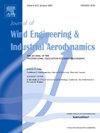Flow configuration improvement and vortex evolution of staggered cylinders
IF 4.2
2区 工程技术
Q1 ENGINEERING, CIVIL
Journal of Wind Engineering and Industrial Aerodynamics
Pub Date : 2025-02-01
DOI:10.1016/j.jweia.2025.106012
引用次数: 0
Abstract
Wind tunnel experiments were performed to collect surface pressure data on twin staggered cylinders with longitudinal pitch ratios (L/D) of 2.4–7.7 and transverse pitch ratios (T/D) of −4 to 0 at Re = 4 × 104. Simultaneous measurements of the pressure and velocity fields were performed for typical flows. Seven distinct flow configurations were identified and classified, including a newly discovered one termed the shear layer low-frequency swinging (SLS) flow configuration. This configuration arises from the periodic swinging of the inner shear layer of the downstream cylinder, alternating between vertical and horizontal orientations with respect to the flow direction at a Strouhal number of 0.03. The surface pressure properties of the downstream cylinder are analyzed by investigating the vortex formation and evolution. Various vortex evolution processes have been discussed, including periodic and persistent reattachment, incident vortex collisions, gap-vortex pairing and rushing, high-frequency vortex merging, and high-frequency modulation. The high-frequency modulation interrupts the shedding of low-frequency vortices from the outer side of the downstream cylinder, leading to the intermittent formation of two vortices during one low-frequency period. Except for the twin street flow configuration, each shear layer of the downstream cylinder sheds vortices at different rates in the two-frequency case.
交错圆柱流动构型改进与涡演化
在Re = 4 × 104条件下,对纵向节距比(L/D)为2.4 ~ 7.7,横向节距比(T/D)为- 4 ~ 0的双交错圆柱进行了风洞实验。同时测量了典型流动的压力场和速度场。研究人员对7种不同的流动形态进行了识别和分类,其中包括一种新发现的剪切层低频摆动(SLS)流动形态。这种结构是由下游圆筒内剪切层的周期性摆动引起的,相对于流动方向在垂直方向和水平方向之间交替,斯特劳哈尔数为0.03。通过研究涡流的形成和演化,分析了下游气缸的表面压力特性。讨论了各种涡旋演化过程,包括周期性和持续性再附着、入射涡旋碰撞、间隙-涡旋配对和冲激、高频涡旋合并和高频调制。高频调制阻断了下游圆柱体外侧低频涡的脱落,导致在一个低频周期内间歇形成两个涡。除了双街流配置外,在双频情况下,下游圆柱的每个剪切层都以不同的速率产生涡。
本文章由计算机程序翻译,如有差异,请以英文原文为准。
求助全文
约1分钟内获得全文
求助全文
来源期刊
CiteScore
8.90
自引率
22.90%
发文量
306
审稿时长
4.4 months
期刊介绍:
The objective of the journal is to provide a means for the publication and interchange of information, on an international basis, on all those aspects of wind engineering that are included in the activities of the International Association for Wind Engineering http://www.iawe.org/. These are: social and economic impact of wind effects; wind characteristics and structure, local wind environments, wind loads and structural response, diffusion, pollutant dispersion and matter transport, wind effects on building heat loss and ventilation, wind effects on transport systems, aerodynamic aspects of wind energy generation, and codification of wind effects.
Papers on these subjects describing full-scale measurements, wind-tunnel simulation studies, computational or theoretical methods are published, as well as papers dealing with the development of techniques and apparatus for wind engineering experiments.

 求助内容:
求助内容: 应助结果提醒方式:
应助结果提醒方式:


